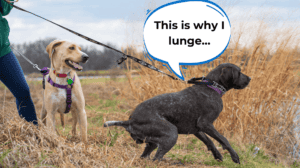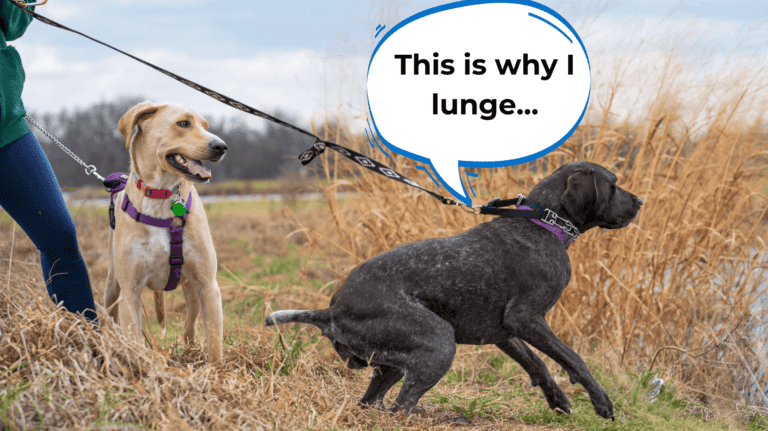Timeout for dogs is a powerful dog training tool that enforces correct behavior WITHOUT hurting your relationship with your pets.
As a dog trainer, I am a big advocate of timeout for dogs as a way of discipline. In my training, I value connection before correction.

I absolutely know that shouting, scaring, and threatening our puppies and dogs to obedience can only work so much.
But I get it — training puppies and dogs can be hard and frustrating so furparents often resort to the old ways because nothing seems to work.
This blog aims to remind you, dear dog owner, that there’s a powerful tool that you can still use: TIMEOUTS.
In this blog, I’m going to talk more about timeouts, how to do it right, and how to make them truly work for your dogs.
Key Takeaways:
- You can discipline and train your dog without using force or threatening them. In fact, this form of discipline is more effective.
- You can make timeouts more effective by understanding the foundation for timeouts including the appropriate time duration, and how to do timeouts with love.
- Dogs respond fast. Calm and consistent consequences is your powerful partner to ensuring negative behavior is stopped.
JOIN MY FREE REACTIVITY CLASS
Table of Contents:
- Timeout for Dogs: How Timeout Taught a Dog to Stop a Bad Behavior
- Do Timeout for Dogs Work in Improving Dog Behavior?
- The Truths About Timeout for Dogs That Dog Owners Should Understand
- Timeout for Dogs: Things to Know Before Starting the Process
- When to Start Giving Timeout for Dogs
- Timeout for Dogs: How to Make Timeouts Effective
- Best Benefits of Timeout for Dogs and Dog Owners
- Timeout for Dogs: How to Communicate Love to Dogs Even While on Timeout
- Timeout for Dogs: How Long Should Timeouts Be?
- Conclusion: Timeout for Dogs Can Be Your Powerful Partner in Training Your Dog and Encouraging Correct Behavior
Timeout for Dogs: How Timeout Taught a Dog to Stop a Bad Behavior
I worked with a dog who had this habit of chewing wires. Check out the full video below for the story.
Now chewing wires is not just generally unsafe for Jack, the dog, but it also posed a risk for damages.
The first time Jack chewed on the wires, I quietly took him into the bathroom and left him for a few minutes.
After the first timeout, Jack continued to head over to the wires.

Calmly, I once again led him to the bathroom.
After he got out of the second timeout, he looked at the wires then looked at me as if saying:
“I’m going to try again to see if you’re really putting me in timeout because of this.”
He went to the wires for the third time.
However, after the third timeout, he caught on: he was placed in the bathroom because he was chewing the wires. When he came out, he totally stopped going to the wires.
It was a beautiful thing to witness!
LEARN THE DOG CALMING CODE (FOR FREE)
Do Timeouts for Dogs Work in Improving Dog Behavior?
In my years as a dog trainer, I have stopped multiple bad behaviors without raising my voice or threatening dogs.
But it’s understandable that dog parents — like you — hesitate to give timeouts for puppies and dogs.

“Doggy Dan, is leaving my dog alone really going to work?”
To answer that, let me share a quick analogy.
Timeouts for Dogs are Like Timeouts for Kids
Raising a dog is similar to raising a child in many ways — they're both naturally curious and adventurous.
However, as parents would know, shouting or telling off a child does not always work. It can lead to arguments, tears, and lots of negative emotions for both the parent and the child.

While I believe that boundaries and consequences are important for children, I don't condone the use of fighting, shouting, or hitting.
The same holds true for dogs.
Teaching good behavior and correcting bad habits can be stressful, but adding more stress doesn't help.
In fact, in my previous blog about dog anxiety and stress, I explained that when dogs are agitated, it's harder for them to learn.
That's where timeouts come in.

Timeouts for dogs is an effective dog training method where you correct negative behavior by helping the dogs understand that certain habits have consequences that they will not like.
There's no need to shout, hit, or show dominance. Your dog will learn what they're doing wrong, and it will be a less stressful experience for both you and your furry companion.
GET MY 5 GOLDEN RULES FOR FREE!
The Danger with Fear-Based Obedience in Dogs
During consultations with dogs, owners usually come to me and say:
“But Doggy Dan, do we still need to give dogs timeout to discipline them? They’re obeying pretty well when I raise my voice.”
Dogs can obey out of fear, and out of knowing that disobedience will mean hitting.

However, when a dog’s obedience is based on fear, it would be harder for you to sustain that obedience or earn your dog’s trust.
And without trust, it will be difficult to train dogs.
Dogs will grow up and figure out a way around your anger or threats, so they’ll be eventually more challenging to handle.
The Truths About Timeout for Dogs That Dog Owners Should Understand
Timeouts for dogs can be an effective tool for encouraging behavior correction, especially when used correctly.
When done properly, many dogs catch on quickly and learn what they're doing wrong.
The key is to use timeouts in a way that provides consistent and clear consequences for unwanted behavior.

I always repeat this to dog owners: calm, consistent, clear corrections all the time.
One Thing to Keep in Mind When Giving Timeout to Dogs
Your dog is a social creature who craves attention, whether positive or negative.
While timeouts may seem like a form of punishment, they can actually be a powerful way to redirect your dog's behavior and reinforce positive habits.
The two-fold approach of giving attention when deserved and using timeouts to correct bad behavior can help your dog understand what is expected of them.
Timeouts for Dogs Should Never Involve Physical Punishment, Shouting, or Other Forms of Negative Attention
Instead, they should be used as a calm and controlled way to help your dog calm down and understand that certain behaviors are not acceptable.

With consistency and patience, timeouts can become an effective part of your discipline strategy for puppies and dogs alike.
FREE REACTIVITY MASTERCLASS
Timeout for Dogs: Things to Know Before Starting the Process
Can timeouts go wrong? Absolutely!
Can timeouts be ineffective? When not done right, yes!
Timeouts are powerful WHEN done correctly. It’s crucial for dog owners to know truths about timeout for dogs including how to prepare a timeout room, and what to do even after timeout.
#1: When preparing a timeout area for your dog, it's important to choose a room that's relatively uninteresting.
Bathrooms, laundry rooms, and even the occasional spare toilet can make for good timeout spaces.
The idea is to provide your dog with a safe place to calm down and reflect on their behavior without any distractions.

#2: In addition to being boring, the timeout room should also be safe for your dog.
Remove any potential hazards such as cleaning products or sharp objects, and make sure that there's nothing they can chew on or destroy.
#3: Finally, it's important to emphasize the importance of separation when using timeouts.
While it may be tempting to place your dog in a crate in the same room as you, this can actually be counterproductive.
The point of a timeout is to give your dog some space to cool down and reflect on their behavior, so it's best to place the crate in another room where they can't see or hear you.

This will help reinforce the idea that their behavior is not acceptable, without making them feel like they're being punished by being banished to the same room as you.
When to Start Giving Timeout for Dogs
There are several behaviors that may indicate the need for a timeout, but this list is not exhaustive.
Some of these behaviors include demanding barking for attention, incessant play biting, repetitive jumping on people, excessive licking, constant pawing for attention, and inappropriate behavior with other dogs.

This is the general rule I give dog owners: if there’s a behavior that you want to stop IMMEDIATELY, don’t delay giving timeouts.
Timeout for Dogs: How to Make Timeouts Effective
When it comes to doing timeouts for your dog, following a few key steps ensures that timeouts are effective and done correctly.
REVERSE REACTIVITY (FREE WEB CLASS)
Here are a few steps to follow to make the timeout process for dogs work.
#1: Lead Them to the Timeout Room Yourself
First, take your dog's collar and lead them to the timeout room, which should be a fairly boring space like a bathroom, laundry room, or toilet.
Don’t use shouting as a way to making them go to the timeout room. Do it yourself, and do it in a calm way.
#2: Calmly But Firmly Put Your Dog Into Timeout
Avoid yelling, scolding, or getting angry as this will only increase their stress and anxiety.

Timing is important. Once they start showing negative behavior, proceed to timeout ASAP. This will help your dog associate timeout with the behavior immediately.
#3: Temporarily Withhold Affection. Remember, You’re Giving a Consequence
If your dog is small enough, you can carry them to the timeout room, but avoid cuddling or giving them any kind of affection.
This is not a punishment, but rather a way to calmly and safely separate them from the situation.
#4 Leave Your Dog for a Minute or Two, Then Assess If Your Dog Needs a Longer Timeout
If your dog is a non-stop barker, you may need to wait a little longer until they calm down.
REACTIVITY SOLVED (NO FOOD, NO FORCE)
All dogs eventually give up and will learn that being quiet is the key to getting out of timeout. When they are quiet, open the door and let them out.
#5 Continue to Establish Silence, Even After They Come Out of the Timeout Room
Remember that when a dog’s in timeout, it’s a process. They are figuring out what timeout is for even after their time inside the room.
Observe quietly at first, then determine if your dog caught on.

#6: If Your Dog Continues to Misbehave After Being Let Out of Timeout, Simply Put Them Back in and Increase the Duration of Their Timeout
Don’t lose your cool. Show to your dog that nothing ruffles your feathers. Calmly put them back to the timeout room and increase timeout time if necessary.
#7: Practice calm, consistent consequences for your dog's behavior.
Over time, your dog will learn what is expected of them and will be less likely to misbehave.
The secret is to really be consistent when giving timeout to dogs. When they misbehave, give timeouts NOT as punishments but as a way of letting them know something’s not right.
By following these steps, you can use timeouts effectively to teach your dog what is acceptable behavior and what is not.

Best Benefits of Timeout for Dogs and Dog Owners
Timeout is beautiful. Together with thousands of dog owners, we have discovered that changing unwanted behavior WITHOUT aggression is possible!
We realized that timeouts for dogs don’t just help dogs — it helps dog owners as well.
Benefit #1: Gap between Action and Reacting
Timeouts give us a moment to pause and reflect before responding to our dog's behavior. It allows us to create a gap between the action and our reaction.

This gap gives us time to consider our dog's behavior and how we want to respond. This approach to training helps to create a calmer and more controlled environment for both us and our dogs.
Benefit #2: Able to come down and respond appropriately and not just react
Timeouts help us to respond appropriately to our dog's behavior rather than simply reacting.
When we react to a situation, we are often driven by our emotions, which can result in an overreaction or an inappropriate response.
A timeout provides us with an opportunity to calm down, take a breath, and respond appropriately to the situation.

Benefit #3: With timeout for dogs, we’re calmer
Timeouts help us to remain calm in the face of challenging behavior from our dogs. It can be frustrating when our dogs misbehave, and it is easy to become angry or upset.
However, timeouts give us a moment to step back and take a deep breath, which helps us to stay calm and composed.
Benefit #4: We’re happier that we remained calm rather than frustrated
Timeouts can help us to feel happier with the way we handle challenging situations with our dogs.
JOIN MY FREE REACTIVITY CLASS
When we react impulsively, we often feel guilty or frustrated afterward.
However, by taking a timeout, we can respond in a more thoughtful and measured way, which can leave us feeling more satisfied with our handling of the situation.

Benefit #5: We give ourselves and our dog a break
Timeouts allow us to take a break from the stress and frustration that can come with challenging behavior from our dogs.
It gives us a moment to step back, take a deep breath, and regroup, so that we can approach the situation with a fresh perspective and renewed patience.
Benefit #6: Dogs dislike timeouts and not us
Timeouts are not harmful or scary for dogs when done correctly.
Dogs dislike the removal of attention, but they do not hold a grudge or harbor any resentment towards us.
Instead, timeouts can be a helpful way to communicate with our dogs that their behavior is not acceptable, and it gives them a chance to reflect on how they can change their behavior to earn our attention and affection.

Benefit #7: We don’t hurt our beloved dogs
Timeouts are a non-physical way to address challenging behavior from our dogs. Unlike physical corrections, timeouts do not cause any physical harm to our dogs, and they do not damage the bond of trust and respect that we have with our dogs.
LEARN THE DOG CALMING CODE (FOR FREE)
Benefit #8: Our dog is given the chance to think about a behavior they need to change:
Timeouts give our dogs a chance to reflect on their behavior and think about how they can change it to earn our attention and affection. It gives them an opportunity to learn from their mistakes and develop new, more appropriate behaviors.
This approach to training is not only effective but also builds a stronger bond between us and our dogs.
Timeout for Dogs: How to Communicate Love to Dogs Even While on Timeout
Timeouts can be a loving way to help your dog learn good behavior, while reducing stress for both you and your pet.

In this section, we will explore how to use timeouts to communicate love to your dog even while enforcing rules.
Positive Timeout Tip #1: When We Give Dogs A Timeout, We Do It With A Calm And Composed Demeanor
This helps them understand that their behavior has consequences, without causing them undue stress or fear.
Over time, with consistent and loving timeouts, dogs learn that good behavior earns positive attention. By providing structure and guidance, we help them feel more secure and confident in their place in the household.
GET THE DOG CALMING CODE™
Positive Timeout Tip #2: It's Important To Remain Silent Throughout The Timeout Process.
Any vocalization from you, whether it's a grunt or a sigh, can be interpreted as a sign of weakness by your dog. This may encourage them to continue the behavior that led to the timeout in the first place.

Positive Timeout Tip #3: To Become A Respected Leader In Your Dog's Eyes, It's Crucial To Remain Calm And Consistent In Your Approach.
This means setting clear boundaries and enforcing them firmly, without losing your cool or getting emotional. When your dog challenges you, stay firm and confident in your approach.
Positive Timeout #4: In The Midst Of A Timeout, It Can Be Tempting To Slam The Door Or Otherwise Express Your Frustration.
However, this kind of behavior will only serve to escalate the situation. Instead, focus on projecting a calm, assertive energy that lets your dog know you are in control.

Positive Timeout #5: Finally, It's Important To Remember That Timeouts Should Not Be Used To Scare Or Punish Dogs.
The goal is to provide a clear and consistent message that certain behaviors are unacceptable, while also helping your dog feel safe, secure, and loved. With the right approach, timeouts can be an effective tool for training and behavior modification.
Timeout for Dogs: How Long Should Timeouts Be?
Determining the appropriate length of time for timeouts can be challenging. The duration of a timeout can vary based on the dog's age, temperament, and behavior.
Recommended Timeout Length For Younger Dogs
Just a minute or two for younger dogs or a few months older because they can be excessively stressed.
Recommended Timeout Length For Larger Dogs
For larger dogs or those with more persistent behavioral issues, timeouts can last longer, but it is important to remember that the goal of the timeout is to allow the dog to calm down and reflect on their behavior, not to punish them.
As a general rule, timeouts should not last more than 15 minutes.

Length of Timeout Depends on the Severity of Your Dog’s Behavior
For minor infractions, a shorter timeout may be appropriate, while for more serious or dangerous behaviors, a longer timeout may be necessary to ensure the safety of both the dog and those around them.
GET MY 5 GOLDEN RULES FOR FREE!
It's important to note that the focus should not be solely on the length of the timeout, but on the effectiveness of the timeout in correcting the behavior.
If a shorter timeout is not effective in correcting the behavior, then a longer timeout may be necessary, and vice versa.
Ultimately, the length of the timeout should be determined based on the individual needs of the dog and the specific behavior that needs to be corrected.

It's important to use timeouts as a tool to help the dog learn and improve their behavior, rather than as a form of punishment.
Conclusion: Timeout for Dogs Can Be Your Powerful Partner in Training Your Dog and Encouraging Correct Behavior
By taking a loving and consistent approach, you can communicate to your dog what is and isn't acceptable in a way that they understand.
With patience and perseverance, your dog will learn to associate positive behavior with positive outcomes, making them a happier and better-behaved pet.
Remember: always remain calm and loving, and your dog will respond in kind.
Don't be afraid to give timeouts a try – they may just become your new powerful partner in dog training!

~ Doggy Dan













6 Responses
Hi, I’ve been using timeouts with my 8mo old adolescent pup and they seem to be very effective in the house. Although on walks, he has a bad habit of jumping on us and biting his leash and whoever is holding the leash while on walks. He is dog reactive (VERY excited to see other dogs) and these outbursts tend to happen after we’ve seen triggers/he’s over threshold. We try to avoid triggers as much as possible and keep ample distance and redirect him. However, there are times it happens seemingly out of nowhere (no dogs present, but maybe we just moved him before he wanted to keep walking).
He’s a large dog already (~80lb) and I’d really like to implement time outs on his walks, but don’t know how to. We’ve been instructed to ignore him when he’s throwing these fits, but with his size and how hard he’s biting, that’s nearly impossible. We’ve also been suggested to tell him we’re taking him to timeout, start walking back home, and crate him, but I don’t think he will connect the dots since we’re usually 15-20min away from home (and getting him to stop jumping/biting enough to walk is already a massive challenge). As an “emergency brake,” a trainer suggested stepping on his leash enough to stop him from jumping, which (although tricky) works, but he will keep biting at the leash/our legs. What would you suggest?
Thank you so much!
Tie him to the nearest post and wait until hescakm before continuing. Say nothing.
For future reference unfortunately I cannot respond to every training question however, if you sign up for the Complete Pack, there’s a forum within the program, which is the best place to post these questions. Our very experienced trainer Hayley will then give you a detailed response. Theres also a lot more training content within. You can get in touch with the help desk to find out more. Cheers Dan
This is super helpful! I’d like to try this… I’m wondering if this would still be effective for a behavior that really only happens in the moment. It’s more of an aggression/resource guarding issue. So, she doesn’t really do it back to back like the example of the dog going back to the electric cords after timeout.
Hi Kara,
Time-Out can work in response to aggression, but you do need to be careful how you implement it. If your dog is reacting in a possessive way around food then my advice would be to ensure they are not disturbed when eating, so that they don’t feel the need to defend that resource. It’s in their instinct that when food is in their possession that they have the right to defend it….so I don’t try to interfere with them when they are eating food or chews/bones.
Time-Out can be an effective tool in response to aggression, but make sure you are doing this safely and calmly. If your dog is reacting aggressively towards you then a better option for Time-Out would be for you to leave the room and close the door behind you so that your dog cannot follow you. The consequence is still the same, they lose you as a result of their behaviour, but this version doesn’t need you to take hold of your dog. Hope that makes sense! Doggy Dan
That was good….JMJ
How do I do this with my two border collies, they are eight years old and are brothers. They have been with me since birth.
No matter the age, the techniques I use…Time-Out for example…..are relevant and will work is done consistently. For more info about exactly how to apply my techniques with your dogs, you can check out my website TheOnlineDogTrainer.com it shows you very clearly how to achieve this. All the Best, Doggy Dan